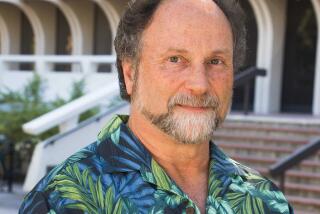Homeowners of Encino Are ‘Only Against 99% of Everything’
It was a rainy evening when the Homeowners of Encino got together for their monthly meeting, surrounded by about the only remaining Encino farmland, a community vegetable patch.
The homeowners met in a tiny building at the Sepulveda Garden Center on Magnolia Boulevard, which “is usually used for gardening classes,” said homeowner Peggy Jaeger. “Like, ‘How to Prune Roses.’ ”
The meeting was about cutting back another kind of growth.
As the homeowners trickled in, Gerald Silver, one of seven board members, set up shop behind a folding table at the front of the room. He methodically lined up his leaflets, maps and information packets solitaire-style on the table.
To the Homeowners of Encino, the sound of time marching on is a deafening roar. The vocal Silver is the guiding spirit of their 11-year-old movement, an impassioned John Brown calling for abolition of the inevitable.
“This was a placid little place, really sedate,” said Jaeger, who has lived on Balboa Boulevard right across from the now-defunct Rancho Los Encinos Hospital since 1961. She dreamily reminisced about how nice it was back then, when her home was surrounded by farms instead of big, tall medical centers.
Silver and 24 neighbors came out in the rain to discuss three issues in a constantly changing lineup of concerns: Ventura Boulevard electric trolleys, the apartment project being developed for Rancho Los Encinos Hospital and the elevated train proposed for the Ventura Freeway.
The February, 1991, Homeowners of Encino newsletter featured a pastiche of words such as “high rise,” “traffic,” “smog,” “crime,” “noise,” “congestion,” “graffiti,” “stress” and “tension” under the title “Anxiety Among Homeowners.”
In the newsletter, the elevated train proposal was greeted with all the enthusiasm of Tokyo householders awakening to Godzilla’s destructo-feet move to the suburbs. It would not be hard to picture frightened Encino residents grabbing their children and running for their lives from this urban overflow run amok.
“URGENT NOTICE!!!” announced the yellow insert. “ELEVATED TRAIN ON THE VENTURA FREEWAY . . . For those who live along the freeway, this will be an unmitigated disaster . . . trains looming over our homes, and land taken for stations. . . . Take this threat seriously!”
“People say we’re against everything,” Silver had said a few days before. “But we’re only against 99% of everything. The 1% of things that are good, we are for.”
This night’s meeting included three guests, all vying to squeeze into that narrow percentile.
A pair of Rapid Transit District officials wheeled a television monitor and VCR through the gardens and into the room. They displayed large color photographs of orange and white Canadian-built electric trolleys on city streets to buttress their four-minute film on the joys of the non-smelly, non-noisy, non-diesel-fueled public mode of transportation being studied by RTD.
The homeowners listened politely to the pros and cons of unsightly overhead wires vs. diesel pollution.
But they were really there to duel with the next speaker, Ben Reznik, a lawyer representing the developer planning to put 189 rental units where Rancho Los Encinos Hospital operated before its demise.
Holding up maps and plans for the project, which has already been approved and modified, Reznik patiently explained the current designs, throwing around a lot of developer talk about zoning, pricing and parking that these homeowners had heard before. Previous plans to put condos into that space had failed, he said, so his client came up with the current design which calls for luxury studio, loft, one- and two-bedroom apartments.
The word “apartments” hit a nerve. Calling the project a “disaster and nightmare for Encino,” Silver denounced the apartments as lacking that “pride of ownership” that is the very backbone of Encino.
Other homeowners chimed in with reasons to fear an apartment complex.
“I work in an area where there are beautiful apartments. They have two, three families living there and they destroy them. They have kids up and down,” warned one.
“I don’t want to see Encino turned into another Westwood,” said another.
When Reznik pointed out that at rents of $1,200 or more, tenants would be more stable than those in cheaper apartments, one resident yelled out, “That’s a dream!”
“From a humanistic standpoint, we want to preserve the lifestyle of those of us who are here, and our children,” Silver finally proclaimed.
Reznik stood firm. “This is not going to be turned into a ghetto,” the lawyer, an Encino resident himself, promised. He pointed out his client’s large investment in the property and his credentials as the developer of other posh apartments in the Wilshire corridor.
“With features like intercoms, high security, barbecues, trash chutes, European kitchen cabinets, walk-in custom closets, microwave ovens and vertical blinds,” Reznik asserted, these apartments would be the equal of the most desirable condo.
And, he added, the number of units was carefully calculated to avoid putting into effect a density bonus that would actually force the developer under city law to include low-income housing along with the luxury units.
“That’s what we’re trying to avoid,” he said.
“We’ve heard that density bonus threat before,” Silver said derisively. He is unafraid, he made clear, of the specter of low-income housing rearing its ugly head in his neighborhood.
“If you think you can sell that here in Encino, go ahead and try it.”
More to Read
Sign up for Essential California
The most important California stories and recommendations in your inbox every morning.
You may occasionally receive promotional content from the Los Angeles Times.










